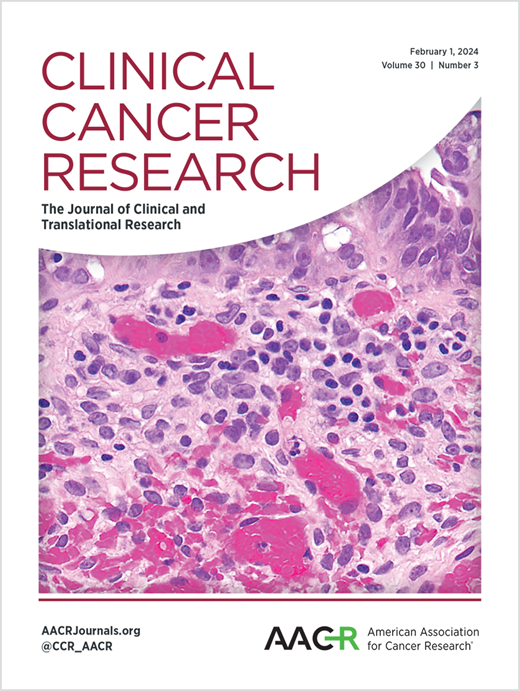Integrative Immune Signature of Complementary Circulating and Tumoral Biomarkers Maximizes the Predictive Power of Adjuvant Immunotherapeutic Benefits in High-Risk Melanoma.
IF 10
1区 医学
Q1 ONCOLOGY
引用次数: 0
Abstract
PURPOSE Ipilimumab (IPI) improved outcomes for high-risk melanoma patients compared to interferon-α2b (IFN) in E1609, a phase III adjuvant trial. We hypothesized that combining candidate immune biomarkers in both tumor and circulating blood could generate a superior predictive biomarker signature. PATIENTS AND METHODS We conducted gene expression profiling on baseline tumors of patients treated with IPI and IFN. We also performed multicolor flow cytometry to compare cellular marker expressions on thawed peripheral blood mononuclear cells and multiplex Luminex to measure serum biomarkers. We tested the expression levels of 31 genes and 40 circulating biomarkers in relation to survival outcomes. We then developed two separate multivariate Lasso-Cox regression models followed by integrative modeling of risk prediction using the prioritized biomarkers. RESULTS In blood, enriched populations of CXCR3+CD4+ T cells, CXCR3+CD8+ T cells, CTLA4+IFN-γ+CD8+ T cells, and higher levels of CCL3 and CXCL11 were associated with significantly improved overall survival (OS) and relapse-free survival (RFS), while high levels of CTLA4+Treg (CD3+CD4+CD25hi+CD152+) and monocytic (M)-MDSC (Lin-CD33+HLA-DrloCD14+CD15+) cells correlated with worse OS and RFS. In tumor, CXCL9, CD8A, CXCL10, and INPP5D were identified as Tier-1 (P<0.05) and IDO1, IGKC, IL2RB as Tier-2 (P<0.1) biomarkers of survival. Multivariate survival analysis identified that ~50% of the risk groups were defined by circulating and tumor biomarker models, indicating complementary features of defining risk groups in IPI-treated but not in IFN-treated patients. CONCLUSIONS Integrating candidate blood and tumor immune-related biomarkers generated a baseline signature that maximizes the prediction of immunotherapeutic benefits in reference to the compartmental biomarker signatures.互补循环和肿瘤生物标志物的综合免疫特征最大化了高危黑色素瘤辅助免疫治疗益处的预测能力。
目的:与干扰素-α2b (IFN)相比,在E1609 III期辅助试验中,ipilimumab (IPI)改善了高风险黑色素瘤患者的预后。我们假设结合肿瘤和循环血液中的候选免疫生物标志物可以产生更好的预测性生物标志物。患者和方法我们对接受IPI和IFN治疗的基线肿瘤患者进行了基因表达谱分析。我们还进行了多色流式细胞术来比较解冻的外周血单核细胞和多重Luminex来测量血清生物标志物的细胞标志物表达。我们测试了与生存结果相关的31个基因和40个循环生物标志物的表达水平。然后,我们开发了两个独立的多变量Lasso-Cox回归模型,然后使用优先生物标志物进行风险预测的综合建模。结果在血液中,CXCR3+CD4+ T细胞、CXCR3+CD8+ T细胞、CTLA4+IFN-γ+CD8+ T细胞、CTLA4+IFN-γ+CD8+ T细胞以及较高水平的CCL3和CXCL11与总生存期(OS)和无复发生存期(RFS)显著改善相关,而高水平的CTLA4+Treg (CD3+CD4+CD25hi+CD152+)和单核细胞(M)-MDSC (lincd33 +HLA-DrloCD14+CD15+)与较差的OS和RFS相关。在肿瘤中,CXCL9、CD8A、CXCL10和INPP5D被鉴定为1级(P<0.05), IDO1、IGKC、IL2RB被鉴定为2级(P<0.1)生存生物标志物。多变量生存分析发现,约50%的危险组是由循环和肿瘤生物标志物模型定义的,这表明在ipi治疗的患者中定义危险组具有互补特征,而在ifn治疗的患者中则没有。综合候选血液和肿瘤免疫相关生物标志物可生成基线标记,根据区隔生物标志物标记可最大限度地预测免疫治疗益处。
本文章由计算机程序翻译,如有差异,请以英文原文为准。
求助全文
约1分钟内获得全文
求助全文
来源期刊

Clinical Cancer Research
医学-肿瘤学
CiteScore
20.10
自引率
1.70%
发文量
1207
审稿时长
2.1 months
期刊介绍:
Clinical Cancer Research is a journal focusing on groundbreaking research in cancer, specifically in the areas where the laboratory and the clinic intersect. Our primary interest lies in clinical trials that investigate novel treatments, accompanied by research on pharmacology, molecular alterations, and biomarkers that can predict response or resistance to these treatments. Furthermore, we prioritize laboratory and animal studies that explore new drugs and targeted agents with the potential to advance to clinical trials. We also encourage research on targetable mechanisms of cancer development, progression, and metastasis.
 求助内容:
求助内容: 应助结果提醒方式:
应助结果提醒方式:


